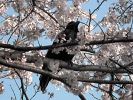Eye For Film >> Movies >> Tokyo Waka (2012) Film Review
As it has expanded both outward and upward, Tokyo’s human population has multiplied and intensified. A city that exceeds 13 million people, however, has ecological repercussions. One such consequence has been the steady proliferation of waste, which invites and feeds the 20,000 crows that now cohabit the Japanese capital. Divisive to locals, a growing concern for authorities and of immediate interest to tourists, these avian intruders have migrated from the rainforests to the south-east of the metropolis, and in John Haptas and Kristine Samuelson’s subtly symphonic documentary, they make for a curious cinematic “other” – one that, for the purposes of the film, is more complementary to the cityspace than contradictory.
With eerie images of these birds sitting rather indifferently on power cables – as if to remind us of the everyday constructs we now take for granted – Tokyo Waka opens more as a disquieting horror film than the city poem its title suggests it to be (“waka” is a form of Japanese poetry). As Todd Boekhelheide’s musical score and Pete Horner’s evocative sound design quickly demonstrate, however, the film chimes along in a contemplative manner, as its makers shape an image of and ode to the eponymous city through an original and ruminative framework. Their methods and aims are to celebrate the multiplicity of human perspectives by probing various interviewees on the subject of their avian neighbours.

These include a homeless citizen, two members of art collective Pom Chim, a Buddhist monk, a zookeeper, an architect, a tofu street vendor and, of course, an ornithologist. Haptas and Samuelson do well to weave these voices against and over one another in a seamless narrative, while the crisp visuals depict the interrelation between the crows and their adopted environment. Some responses to the birds have a scientific edge, while others are more philosophical. Later in the film, the monk notes with some poetry that since garbage is the remains of human desire, we may see in these creatures the post-hoc reflections of our own over-consumption – which may be the root cause of why their presence is so unwelcome.
The neon showcase that makes Tokyo-at-night such a film-friendly space is only sparingly present here. Even – or perhaps especially - by day, though, it’s a patchwork city, homogeneous in design but multifarious in its experiences. The ubiquitous cawing on the soundtrack suggests the crow is a constant fixture in this postmodern jungle, but as characters in themselves, the birds make for remarkably varied photographic subjects. We watch with much amusement, for instance, as one crow negotiates an object of clear interest from a bottle that it can’t retrieve by direct means, and as another endures the trial and error of placing a nut in the path of oncoming traffic so that a car may break its shell. If such moments contradict the street signs that warn, “beware of crows overhead”, others add real-life Hitchcockian terror, such as that in which a crow swoops down to confront an unfortunate passerby.
As in Hitchcock’s The Birds (1963), Tokyo’s winged residents seem to be here for the long-term. Causing filmmakers and audience members alike to look up, however, in aesthetic terms at least Tokyo’s crows help shape our understanding of the city by drawing attention to its verticality and horizontality, and the effects each has on displacement and dwelling – human or otherwise.
Reviewed on: 13 Apr 2013


















